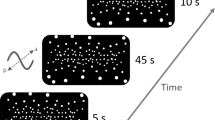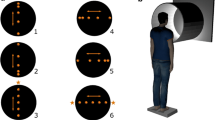Abstract
How does the spatio-temporal structure of an oscillating radial optical flow affect postural stability? In order to investigate this problem, two different types of stimulus pattern were presented to human subjects. These stimuli were generated either with a constant spatial frequency or with a spatial frequency gradient providing monocular depth cues. When the stimulation was set in motion, the gain response of the antero-posterior postural changes depended upon the oscillation frequency of the visual scene. The amplitude of the postural response did not change with the amplitude of the visual scene motion. The spatial orientation of the postural sway (major axis of sway) depended strictly and solely on the structure of the visual scene. In static conditions, depth information resulting from the presence of a spatial frequency gradient enhanced postural stability. When set in motion, a visual scene with a spatial frequency gradient induced an organization of postural sway in the direction of the visual motion. Considering visual dynamic cues, postural instability depended linearly both on the logarithm of the velocity and on the logarithm of the temporal frequency. A nonlinear relationship existed between the amplitude of the fore-aft postural sway at the driving frequency and the temporal frequency, with a peak around 2–4 Hz. These results are discussed in terms of their implications for the separation of visual and biomechanical factors influencing visuo-postural control.
Similar content being viewed by others
References
Amblard B, Cremieux J (1976) Rôle de l'information visuelle de mouvement dans le maintient de l'équilibre postural chez l'homme. Agressologie 17C: 25–36
Andersen GJ, Braunstein ML (1985) Induced self-motion in central vision. J Exp Psychol Hum Percept Perform 11: 122–132
Andersen GJ, Dyre BP (1989) Spatial orientation from optic flow in the central visual field. Percept Psychophys 45: 453–458
Asten WNJC van, Gielen CCAM, Denier van der Gon JJ (1988a) Postural adjustments induced by simulated motion of differently structured environments. Exp Brain Res 73: 371–383
Asten WNJC van, Gielen CCAM, Denier van der Gon JJ (1988b) Postural movements induced by rotations of visual scenes. J Opt Soc Am [A] 5: 1781–1789
Berthoz A, Droulez J (1982) Linear self-motion perception. In: Wertheim AH, Wagenaar WA, Leibowitz W (eds) Tutorials in motion perception. Plenum, London, pp 157–199
Berthoz A, Pavard B, Young LR (1975) Perception of linear horizontal self-motion induced by peripheral vision (linear vection). Basic characteristics and visuo-vestibular interaction. Exp Brain Res 23: 471–489
Braunstein ML (1968) Motion and texture as source of slant information. J Exp Psychol 78: 510–524
Collins JJ, De Luca CJ (1993) Open-loop and closed-loop control of posture. A random-walk analysis of centre-of-pressure trajectories. Exp Brain Res 95: 308–318
Cutting JE, Millard RT (1984) Three gradients and the perception of flat and curved surfaces. J Exp Psychol Gen 113: 198–216
De Valois R, De Valois K (1988) Spatial vision. Oxford University Press, New York
Delorme A, Martin C (1986) Role of retinal periphery and depth periphery in linear vection and visual control of standing in humans. Can J Psychol 40: 176–187
Denton GC (1971) The influence of visual pattern on perceived speed. Perception 9: 393–402
Dichgans J, Brandt T (1978) Visual-vestibular interactions and motion perception. In: Held R, Leibowitz HW, Teuber HL (eds) Perception. (Handbook of sensory physiology, vol VIII) Springer, Berlin Heidelberg New York, pp755–804
Diener HC, Wist ER, Dichgans J, Brandt TH (1976) The spatial frequency effect on perceived velocity. Vision Res 16:169–176
Dijkstra TMH, Gielen CCAM, Melis BJM (1992) Postural responses to stationary and moving scenes as a function of distance to the scene. Hum Mov Sci 11: 195–203
Fisher MH, Kornmüller AE (1930) Optokinetish ausgelöste Beweeungswahrnehmung und optokinetischer Nystagmus. J Psychol Neurol (Lpz) 41: 273–308
Flückiger M, Baumberger B (1988) The perception of optical flow projected on the ground surface. Perception 17: 633–645
Gibson JJ (1950) The perception of the visual world. Allen and Unwin, London
Gibson JJ (1979) The ecological approach to visual perception. Houghton Mifflin, Boston
Gurfinkel VS (1973) Physical foundations of the stabilography. Agressologie 14C: 9–14
Johansson R, Magnusson M, Akesson M (1988) Identification of human postural dynamics. IEEE Trans Biomed Eng 35: 858–869
Kelly DH (1985) Receptive-field-like functions inferred from large-area psychophysical measurements. Vision Res 25: 1895–1900
Kelly DH (1989) Retinal inhomogeneity and motion in depth. J Opt Soc Am [A] 6: 98–105
Lasley DJ, Hamer RD, Dister R, Cohn TE (1991) Postural stability and stereo-ambiguity in man-designed visual environments. IEEE Trans Biomed Eng 38: 808–814
Lee DN, Lishman J (1975) Visual proprioceptive control of stance. J Hum Mov Stud 1: 87–95
Leibowitz H, Johnson C, Isabelle E (1972) Peripheral motion detection and refractive error. Science 177: 1207–1208
Lestienne F, Soechting JF, Berthoz A (1977) Postural readjustmemts induced by linear motion of visual scenes. Exp Brain Res 28: 262–284
Mach E (1896, 1962) The analysis of sensations. The Optical Society of America, New York
Masson G, Mestre DR, Blin O, Pailhous J (1994) Low luminance contrast sensitivity: effect of training on OKN and psychophysical thresholds in man. Vision Res 34: 1893–1899
Nakayama K, Loomis JM (1974) Optical velocity patterns, velocity sensitive neurons and perception: an hypothesis. Perception 17: 5–12
Nashner LM (1971) A model describing vestibular detection of body-sway motion. Acta Otolaryngol 72: 429–436
Paulus W, Straube A, Krafczyk S, Brandt T (1989) Differential effects of retinal target displacement, changing size and changing disparity in the control of anterior/posterior and lateral body-sway. Exp Brain Res 78: 243–252
Sauvan XM, Bonnet C (1993) Properties of curvilinear vection. Percept Psychophys 53: 429–435
Schöner G (1991) Dynamic theory of action-perception patterns: the moving room paradigm. Biol Cybern 64: 455–462
Schor C, Narayan V (1981) The influence of field size upon the spatial frequency response of optokinetic nystagmus. Vision Res 21: 985–994
Sekuler R (1974) Spatial vision. Annu Rev Psychol 25: 195–232
Stoffregen TA (1985) Flow structure versus retinal location in the optical control of stance. J Exp Psychol Hum Percept Perform 11: 554–565
Stoffregen TA (1986) The role of optical velocity in the control of stance. Percept Psychophys 39: 355–360
Talbott RE (1980) Postural reactions of dogs to sinusoidal motion in the peripheral visual field. Am J Physiol 8: R71-R79
Telford L, Spratley J, Frost BJ (1992) Linear vection in the central visual field facilitated by kinetic depth cues. Perception 21: 337–349
Author information
Authors and Affiliations
Rights and permissions
About this article
Cite this article
Masson, G., Mestre, D.R. & Pailhous, J. Effects of the spatio-temporal structure of optical flow on postural readjustments in man. Exp Brain Res 103, 137–150 (1995). https://doi.org/10.1007/BF00241971
Received:
Accepted:
Issue Date:
DOI: https://doi.org/10.1007/BF00241971




